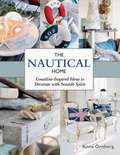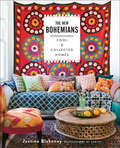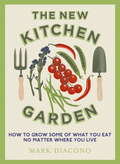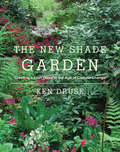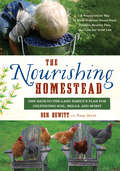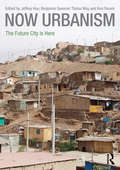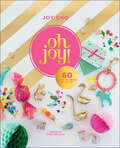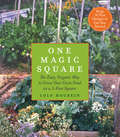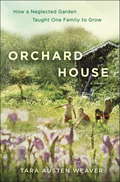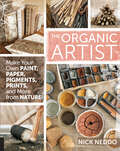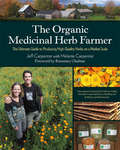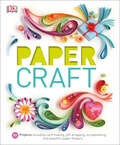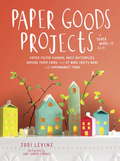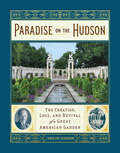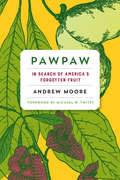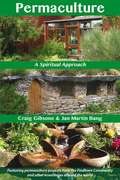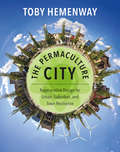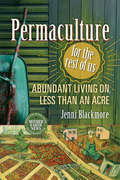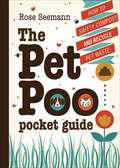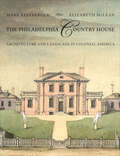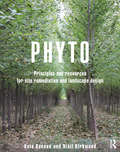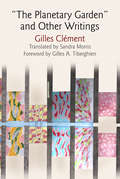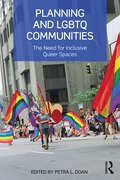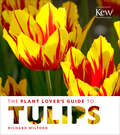- Table View
- List View
The Nautical Home: Coastline-Inspired Ideas to Decorate with Seaside Spirit
by Anna OrnbergAre you a beach bum, a beach lover, or simply just a fan of the water? If you find yourself constantly longing for a relaxing vacation along the sandy shores of Tahiti or yearning to go on a coast-to-coast cruise, look no further. Interior designer Anna Örnberg has all the solutions to bring the waves to your home and living room. With Anna’s advice and expertise, you can turn your own apartment or living space into a beautiful waterfront home. Live on the beach with nautical style and enjoy the waves. Using seashells, ropes, dark woods, and light-colored walls, the interior designs in this book remind readers of sunken ships and buried treasures. The decor will inspire homeowners to personalize their homes into the most calming and soothing living quarters, a place where they can sit, relax, and enjoy the ocean breeze. Projects include: Wooden lampshades Nautical placemats and pot holders Building your own lighthouse Beanbags and pillowcases The nautical look is a classic theme that suits a wide audience. Whether you’re looking for new ideas to spruce up your city center apartment or looking to decorate your holiday vacation home, this book has the answers. The Nautical Home has a little something for everyone, from the average homeowner hoping to reinvent a room or more to the recent college grad looking for new ways to decorate a new home. With the interior designs in this book, you can finally be the captain of your own ship or home.
The New Bohemians: Cool & Collected Homes
by Justina BlakeneyA New York Times bestseller. “With pages of tips and twelve DIY projects, the book makes the free-spirited style easy to achieve.” —Architectural DigestIn The New Bohemians, LA-based designer Justina Blakeney defines the New Bohemians as creative individuals who are boutique owners and bloggers, entrepreneurs and ex-pats, artists and urban farmers.They embrace free-spirited, no-rules lifestyles and apply that attitude to all areas of their existence, including their homes. With little distinction between work and play, the new boho home often includes an office, art gallery, showroom, photography studio, restaurant, or even a pop-up shop. The New Bohemians explores 20 homes located primarily on the East and West coasts. Exclusive interviews with the owners, 12 DIY projects created by Blakeney and inspired by objects found in the homes, and a “Plant-O-Pedia” offer insight into achieving this aesthetic. In addition, each home is accompanied by an Adopt-an-Idea section that offers general decor, styling, and shopping tips for easy duplication in your own home.“The New Bohemians is sure to inspire readers to create, to reuse, to grow, to let loose, and to invite some cool and collected energy into their own homes.” —California Home+Design “A colorful and endlessly inspiring cover-to-cover read . . . From the dreamy homes of twenty stylesetters across the country to easy DIY projects, The New Bohemians is our new favorite coffee table book for home inspiration.” —One Kings Lane“Fans of Justina’s style will be glad to see [the book] reads like a how-to for finding one’s own inner bohemian . . . the book is as functional as it is gorgeous.” —Apartment Therapy
The New Kitchen Garden: The Ultimate Kitchen Garden Guide
by Mark DiaconoLook over the fences into the gardens, patios, courtyards and allotments behind, and you'll see a quiet revolution taking place. Amongst the lawns, the roses and the concrete, more and more of us are growing at least some of what we eat. A kitchen garden can be anything from a collection of pots to a small farm - it all depends on where you live and what space you have to create your own edible plot. The New Kitchen Garden doesn't begin with the usual plan of an allotment quartered into beds awaiting their rotation, it starts by asking what you need from your garden. What follows is a series of invitations - fruits, nuts, herbs, spices, flowers and vegetables to grow and eat. Everything is here - the tools, the techniques, the ideas and the knowledge - to enable you to realise that vision of your own kitchen garden. Mark Diacono - who was head of the gardening team at Hugh Fearnley-Whittingstall's River Cottage - captures the spirit of adventure and imagination of those growing food in the twenty-first century. He takes ideas from gardens around the world, including that of his own home, Otter Farm in Devon, with its unique blend of orchards, vineyards, forest gardens, edible hedges, perennial garden and veg patch. Inspired by a range of gardeners growing food on allotments, on rooftops, in container gardens and in other edible spaces, many of them urban, Mark shows you the full exciting breadth of what a kitchen garden can be. Whether you have a few pots of chillies or a community farm, whether you wish to plant in ordered rows or create an edible jungle, The New Kitchen Garden is for you.
The New Kitchen Garden: How to Grow Some of What You Eat No Matter Where You Live
by Mark DiaconoWhether you are taking your first steps in growing some of what you eat, or experienced and looking for inspiration, ideas and some new plants to grow, The New Kitchen Garden is for you. Inspired by a range of gardeners growing food on allotments, on rooftops, in container gardens and in other edible spaces, many of them urban, Mark shows you the full exciting breadth of what a kitchen garden can be. Whether you have a window sill, space for a few plants by the back door, an allotment or an acre, you'll find a series of invitations to grow any of almost 200 fruits, nuts, herbs, spices, flowers and vegetables to suit your space, time and inclination. Everything is here - the tools, the techniques, the ideas and the knowledge - to enable you to realise that vision of your own kitchen garden, wherever you live. There's also a dozen incredible edible gardens - a rooftop food forest, a courtyard of metre-square raised beds, Charles Dowding's no-dig garden, a child's container garden and Raymond Blanc's heritage garden at Le Manoir among them - their gates flung open by the gardeners to reveal their methods, ideas and techniques, with plans, key plants and photography to accompany. Mark Diacono - who was head of the gardening team at Hugh Fearnley-Whittingstall's River Cottage - captures the spirit of adventure and imagination of those growing food in the twenty-first century. He takes ideas from gardens around the world, including that of his own home, Otter Farm in Devon, with its unique blend of orchards, vineyards, forest gardens, edible hedges, perennial garden and veg patch.No matter whether you have space for a collection of pots or a small farm at your disposal, The New Kitchen Garden will show you how to create the most incredible edible garden you can.
The New Shade Garden: Creating a Lush Oasis in the Age of Climate Change
by Ken DruseThe author of The Natural Shade Garden offers a comprehensive new guide to climate-conscious gardening—beautifully illustrated with 400 photos.There is a new generation of gardeners who are planting gardens not only for their visual beauty but also for their ability to reduce carbon dioxide in the atmosphere. In The New Shade Garden, Ken Druse provides expert advice on creating a shade garden with an emphasis on the adjustments necessary for our changing climate. Druse examines common problems facing today's gardeners, from addressing the deer situation to watering plants without stressing limited resources. Detailing all aspects of the gardening process, The New Shade Garden covers basic topics such as designing your own garden, pruning trees, preparing soil for planting, and the vast array of flowers and greenery that grow best in the shade. Perfect for new and seasoned gardeners alike, this encyclopedic manual provides all the information you need to start or improve upon your own shade garden.
The Nourishing Homestead
by Penny Hewitt Ben HewittA practiculture way to grow nutrient-dense food, produce healthy fats, and live the good life The Nourishing Homestead tells the story of how we can create truly satisfying, permanent, nourished relationships to the land, nature, and one another. The Hewitts offer practical ways to grow nutrient-dense food on a small plot of land, and think about your farm, homestead, or home as an ecosystem. Much of what the Hewitts have come to understand and embrace about their lives of deep nourishment is informed by their particular piece of land and local community in northern Vermont, but what they have gleaned is readily transferable to any place--whether you live on 4 acres, 40 acres, or in a 400-square-foot studio apartment. Ben and Penny (and their two sons) maintain copious gardens, dozens of fruit and nut trees and other perennial plantings, as well as a pick-your-own blueberry patch. In addition to these cultivated food crops, they also forage for wild edibles, process their own meat, make their own butter, and ferment, dry, and can their own vegetables. Their focus is to produce nutrient-dense foods from vibrant, mineralized soils for themselves and their immediate community. They are also committed to sharing the traditional skills that support their family, helping them be self-sufficient and thrive in these uncertain times. Much of what the Hewitts are attempting on their homestead is to close the gaps that economic separation has created in our health, spirit, and skills. Ben uses the term "practiculture" to describe his family's work with the land--a term that encompasses the many practical life skills and philosophies they embody to create a thriving homestead, including raw-milk production, soil remediation, wildcrafting, Weston A. Price principles, bionutrient-dense farming, permaculture, agroforestry, traditional Vermont hill farming, and more. The Nourishing Homestead also includes information on deep nutrition, the importance of good fats, and integrating children into the work of a homestead. The Hewitts' story is reminiscent of The Good Life, by Helen and Scott Nearing, and is sure to inspire a new generation of homesteaders, or anyone seeking a simpler way of life and a deeper connection to the world.
Now Urbanism: The Future City is Here
by Jeffrey Hou Benjamin Spencer Thaisa Way Ken YocomAfter more than a century of heroic urban visions, urban dwellers today live in suburban subdivisions, gated communities, edge cities, apartment towers, and slums. The contemporary cities we know are more often the embodiment of unexpected outcomes and unintended consequences rather than visionary planning. As an alternative approach for rethinking and remaking today’s cities and regions, this book explores the intersections of critical inquiry and immediate, substantive actions. The contributions inside recognize the rich complexities of the present city not as barriers or obstacles but as grounds for uncovering opportunity and unleashing potential. Now Urbanism asserts that the future city is already here. It views city making as grounded in the imperfect, messy, yet rich reality of the existing city and the everyday purposeful agency of its dwellers. Through a framework of situating, grounding, performing, distributing, instigating, and enduring, these contributions written by a multidisciplinary group of practitioners and scholars illustrate specificity, context, agency, and networks of actors and actions in the re-making of the contemporary city.
Oh Joy!: 60 Ways to Create & Give Joy
by Joy ChoA beautiful, joyful, colorful, gifty guide to living in style, from home to food to fashion, from the popular blogger with the world’s biggest Pinterest following—14 million!—and a line of products at Target. Fourteen million Pinterest members look to Joy Cho, a designer, blogger, mother, and founder of the Oh Joy blog, for creative inspiration. Now, she builds on that success to offer a cornucopia of new ideas in this simple yet sophisticated full-color book. Following the unique aesthetic and joyful tone of her blog, Oh Joy! shows you how to add style, detail, color, flavor, and bliss into your daily life. For Joy, it’s the small things that can make a big impact, like decorating cakes with fun toppers, or brightening your home with vibrant pops of color. Joy wants to help you make your world a happier, prettier place and her boundless enthusiasm is infectious. Oh Joy! is packed with quick, easy, and fun projects and fabulous notions for:Fashion: tips for mixing patterns or finding unique pieces at vintage storesDécor: make your own wallpaper and use artificial flowers in unexpected waysEntertaining: suggestions for quirky centerpieces and photo booth backdropsFood: Recipes for striped cakes, surprise confetti cookies, and other bite-sized foodsGifts: Spread the joy with personalized lottery tickets and pop-up wrapping paperIncorporate beauty into the things you do—make your everyday life feel more colorful, fresh, and fun—and get an intimate, gorgeous look into the world of Joy Cho with Oh Joy!
One Magic Square: The Easy, Organic Way to Grow Your Own Food on a 3-Foot Square
by Lolo HoubeinA Hands-On Guide to Growing Organic Vegetables, Fruits and Herbs—Starting with Just One Square Yard!Lolo Houbein has been growing food for more than 30 years—and now, drawing on her wide learning and hard-earned experience, she offers a wealth of information on how to turn small plots of land into sources of nourishing, inexpensive, organic food. Amateur gardeners wondering how to get started and veteran gardeners looking for new ideas will be inspired by Houbein’s practical, often charming, and always optimistic advice. One Magic Square includes:Earth-friendly tips, tricks, and solutions for establishing and maintaining an organic gardenIllustrated, annotated plans for 30 plots with different themes—including perennials and “pick-and-come-again” plants, anti-cancer and anti-oxidant-rich vegetables, and salad, pizza, pasta, and stir-fry ingredientsComprehensive information about every plant in every plotColor photographs of the author’s own garden—plus helpful illustrationsHoubein family recipes for making the most of your bounty—including salad dressings, fruit and vegetable juices, stir-fries, and more.
Orchard House
by Tara Austen WeaverFor fans of Anne Lamott, a profoundly moving memoir of rediscovering, reinventing, and reconnecting, as an estranged mother and daughter come together to revive a long-abandoned garden and ultimately their relationship and themselves. Peeling paint, stained floors, vined-over windows, a neglected and wild garden--Tara Austen Weaver can't get the Seattle real estate listing out of her head. Any sane person would have seen the abandoned property for what it was: a ramshackle half-acre filled with dead grass, blackberry vines, and trouble. But Tara sees potential and promise--not only for the edible bounty the garden could yield for her family, but for the personal renewal she and her mother might reap along the way. So begins Orchard House, a story of rehabilitation and cultivation--of land and soul. Through bleak winters, springs that sputter with rain and cold, golden days of summer, and autumns full of apples, pears, and pumpkins, this evocative memoir recounts the Weavers' trials and triumphs, detailing what grew and what didn't, the obstacles overcome and the lessons learned. Inexorably, as mother and daughter tend this wild patch and the fruits of their labor begin to flourish, green shoots of hope emerge from the darkness of their past. For everyone who has ever planted something that they wished would survive--or tried to mend something that seemed forever broken--Orchard House is a tale of healing and growth set in a most unlikely place.Praise for Orchard House "This touching memoir chronicles how the act of transforming a garden together--of 'planting hope'--helps a mother and daughter reconnect and revive the sense of groundedness that had been lost within their relationship and themselves. . . . [Orchard House] deftly [captures] the love, laughter, trials and tears that make motherhood the joy and job it truly is."--American Way "Honest and moving . . . [the story of] one woman's initiation into intensive gardening with her mother, which changed a neglected space into something beautiful and bountiful and shifted their relationship as well."--Kirkus Reviews "Fascinating, tender, often heartbreaking . . . The perfect gift for a mother or a daughter with an appreciation for the transformative power of gardening."--HGTV Gardens "A wise exploration of family roots . . . Nurturing a garden is a lovely metaphor for healing a family. . . . [Orchard House] could serve as a handbook for both."--Shelf Awareness "With buoyant grace and empathic insights, Weaver offers an ardent tribute to both the science of perseverance and the art of letting go."--Booklist"This is a glorious book--lyrical, honest, compassionate, and wise. It reminds us that gardens and families are messy businesses, but from them we can harvest hope and food and moments of grace."--Erica Bauermeister, author of The School of Essential Ingredients "Filled with sensuous descriptions, this beguiling story enchants. Gardeners and non-gardeners alike will delight in this lyrical tale of how a garden grows a family."--Diana Abu-Jaber, author of The Language of Baklava and Birds of Paradise"Orchard House is a glorious and deeply moving story of one family's redemption. If Anne Lamott and Wendell Berry ever had a literary love child, Tara Austen Weaver might well be her."--Elissa Altman, author of Poor Man's FeastFrom the Hardcover edition.
The Organic Artist: Make Your Own Paint, Paper, Pigments, Prints, and More from Nature
by Nick NeddoDrawing on ancient techniques, a primitive-arts instructor shows how to reconnect with nature by making and using your own all-natural art supplies.The Organic Artist encourages you to return to those days when art was made with all-natural materials, like charcoal and birch bark. Immersing you in the natural world, this book seeks to inspire creativity by connecting you to your organic roots.In addition to offering a wide variety of suggestions for using nature as supplies for art, this book also introduces the concepts of awareness and perception that are foundational to the creative process. You can refine your drawing skills, as well as increase their appreciation for the visual arts and the natural landscape. Projects and skills covered include:Making paper and wild inkWorking with soapstone, clay, wood, and rawhidePrintmaking and stencilingNatural pigments and dyesCamouflage and body paintingNature journaling, and more“Clear, concise and easy to follow . . . a pleasure to both use as a how-to book and read through.” —Michael Pewtherer, author of Wilderness Survival Handbook
The Organic Medicinal Herb Farmer: The Ultimate Guide to Producing High-Quality Herbs on a Market Scale
by Melanie Carpenter Jeff Carpenter Rosemary GladstarA new approach to growing local medicine, including information on geo-authenticity, wildcrafting, and developing a good business plan Both a business guide and a farming manual, The Organic Medicinal Herb Farmer will teach readers how to successfully grow and market organic medicinal Western herbs. Whether you're trying to farm medicinal plants, culinary herbs, or at-risk native herbs exclusively or simply add herbal crops to what you're already growing, successful small-scale herb farmers Jeff and Melanie Carpenter will guide you through the entire process--from cultivation to creating value-added products. Using their Zack Woods Herb Farm in Vermont as a backdrop, the Carpenters cover all the basic practical information farmers need to know to get an organic herb farm up and running, including: * Size and scale considerations; * Layout and design of the farm and facilities; * Growing and cultivation information, including types of tools; * Field and bed prep; * Plant propagation; * Weed control, and pests and diseases; * Harvesting, as well as wild harvesting and the concept of geo-authentic botanicals; * Postharvest processing; and, * Value-added products and marketing. The authors also provide fifty detailed plant profiles, going deeper into the herbs every farmer should consider growing. In an easy-to-understand, practical, and comprehensive manner, readers will learn how to focus on quality over quantity, and keep costs down by innovating with existing equipment, rather than expensive technology.Market farmers who have never before considered growing medicinal herbs will learn why it's more important to produce these herbs domestically. The Organic Medicinal Herb Farmer makes a convincing case that producing organic medicinal herbs can be a viable, profitable, farming enterprise. The Carpenters also make the case for incorporating medicinal herbs into existing operations, as it can help increase revenue in the form of value-added products, not to mention improve the ecological health of farmland by encouraging biodiversity as a path toward greater soil health.
Paper Craft: 50 Projects Including Card Making, Gift Wrapping, Scrapbooking, and Beautiful Pa
by DKPaper Craft makes it easy — and affordable — to design handmade crafts that are guaranteed to impress. Transform your favorite paper into beautiful decorations and home decor, greeting cards, scrapbooks, and beyond, no matter what your skill level.This visual, step-by-step guide outlines all the necessary equipment and materials and contains nifty techniques like scaling, embossing, and crumpling, as well as quilling, decoupage, and paper-mâché. Inside Paper Craft you'll find seasonal and special occasion paper craft ideas to suit a variety of tastes. And, templates and variation suggestions allow you to choose exactly the right look for your projects.Cut, fold, roll, glue, and print your way to crafting heaven with Paper Craft.
Paper Goods Projects
by Jodi Levine Amy Gropp ForbesCraft to your heart's content without making a trip to a specialty store. Once you've glimpsed the inspired creations in Paper Goods Projects, you'll never look at your pantry shelves or recycling bins the same way. Here are 60 fun and simple crafts that transform everyday items: paper towel tubes turn into safari animals, coffee filters dyed bright colors bloom into water lilies, doilies make a charming crown, and cereal boxes become the building blocks of a mini city. Paper Goods Projects has crafts for birthday party favors and decorations, cake toppers, greeting cards, children's toys, and so much more. Tap your creativity like never before to create fun, beautiful objects out of the simplest materials.
Paradise on the Hudson: The Creation, Loss, and Revival of a Great American Garden
by Caroline Seebohm&“Through her prodigious research and evocative prose, Caroline Seebohm recreates an era of New York life seen through the history and dazzling beauty of the restored Untermyer Gardens.&” —Paula Deitz, author, Of Gardens On a single day in 1939, more than 30,000 people visited the Untermyer Garden—at the time, one of the world&’s grandest landscapes. Thirty years later, most of the site had been sold or abandoned. Who was the eccentric visionary behind the estate&’s original glory? What triggered the garden&’s decline and sparked its restoration? In Paradise on the Hudson, Caroline Seebohm brings to light the remarkable story of a larger-than-life figure lost mostly to history, and the impact of his horticultural obsession. It is a fascinating tale about of the role of passion in both creating and rescuing one of America&’s greatest gardening achievements.
Pawpaw
by Andrew Moore Michael W. TwittyThe largest edible fruit native to the United States tastes like a cross between a banana and a mango. It grows wild in twenty-six states, gracing Eastern forests each fall with sweet-smelling, tropical-flavored abundance. Historically, it fed and sustained Native Americans and European explorers, presidents, and enslaved African Americans, inspiring folk songs, poetry, and scores of place names from Georgia to Illinois. Its trees are an organic grower's dream, requiring no pesticides or herbicides to thrive, and containing compounds that are among the most potent anticancer agents yet discovered. So why have so few people heard of the pawpaw, much less tasted one? In Pawpaw, author Andrew Moore explores the past, present, and future of this unique fruit, traveling from the Ozarks to Monticello; canoeing the lower Mississippi in search of wild fruit; drinking pawpaw beer in Durham, North Carolina; tracking down lost cultivars in Appalachian hollers; and helping out during harvest season in a Maryland orchard. Along the way, he gathers pawpaw lore and knowledge not only from the plant breeders and horticulturists working to bring pawpaws into the mainstream (including Neal Peterson, known in pawpaw circles as the fruit's own "Johnny Pawpawseed"), but also regular folks who remember eating them in the woods as kids, but haven't had one in over fifty years. As much as Pawpaw is a compendium of pawpaw knowledge, it also plumbs deeper questions about American foodways--how economic, biologic, and cultural forces combine, leading us to eat what we eat, and sometimes to ignore the incredible, delicious food growing all around us. If you haven't yet eaten a pawpaw, this book won't let you rest until you do.
Permaculture: A Spiritual Approach
by Craig Gibsone Jan Martin BangPermaculture design as divine creative activity. Permaculture looks for the patterns embedded in our natural world as inspirations for designing solutions to the many challenges we are presented with today. It is a philosophical, spiritual and practical approach to the use of the land, integrating microclimate, functional plants, animals, soils, water management and human needs into intricately connected, highly productive systems. In essence, permaculture uses observation as basis for creating sustainable and effective human settlements. The authors discuss the components Earthshare, Fairshare and Peoplecare, with a specific emphasis on the spiritual aspects of the design process. Topics range from soil and plants, energy sources and house design to alternative economics, group process, governance, and spiritual nurturing and enquiry. Examples of existing permaculture structures from around the world, most notably from the Findhorn Community Eco-Village, bring the concepts to life. First-hand accounts of how people got started on their permaculture project lend a personal touch. The first book to look at the spiritual aspects as well as the practical implementation of permaculture design.
The Permaculture City
by Toby HemenwayPermaculture is more than just the latest buzzword; it offers positive solutions for many of the environmental and social challenges confronting us. And nowhere are those remedies more needed and desired than in our cities. The Permaculture City provides a new way of thinking about urban living, with practical examples for creating abundant food, energy security, close-knit communities, local and meaningful livelihoods, and sustainable policies in our cities and towns. The same nature-based approach that works so beautifully for growing food--connecting the pieces of the landscape together in harmonious ways--applies perfectly to many of our other needs. Toby Hemenway, one of the leading practitioners and teachers of permaculture design, illuminates a new way forward through examples of edge-pushing innovations, along with a deeply holistic conceptual framework for our cities, towns, and suburbs. The Permaculture City begins in the garden but takes what we have learned there and applies it to a much broader range of human experience; we're not just gardening plants but people, neighborhoods, and even cultures. Hemenway lays out how permaculture design can help towndwellers solve the challenges of meeting our needs for food, water, shelter, energy, community, and livelihood in sustainable, resilient ways. Readers will find new information on designing the urban home garden and strategies for gardening in community, rethinking our water and energy systems, learning the difference between a "job" and a "livelihood," and the importance of placemaking and an empowered community. This important book documents the rise of a new sophistication, depth, and diversity in the approaches and thinking of permaculture designers and practitioners. Understanding nature can do more than improve how we grow, make, or consume things; it can also teach us how to cooperate, make decisions, and arrive at good solutions.
Permaculture for the Rest of Us
by Jenni BlackmoreMany of us want to increase our self-sufficiency, but few have access to the ideal five sunny, gently sloping acres of rich, loamy, well-drained soil. Jenni Blackmore presents a highly entertaining, personal account of how permaculture can be practiced in adverse conditions, allowing anyone to learn to live more sustainably in a less-than-perfect world. With a rallying cry of "If we can do it, you can too," she distills the wisdom of twenty years of trial and error into a valuable teaching tool.The perfect antidote to dense, high-level technical manuals, Permaculture for the Rest of Us presents the fundamental principles of this sometimes confusing concept in a humorous, reader-friendly way. Each chapter focuses on a specific method or technique, interspersing straightforward explanations with the author's own experiences. Learn how to successfully retrofit even the smallest homestead using skills such as: No-till vs. till gardening, composting, and soil-building Natural pest control and integrating small livestock Basic greenhouse construction Harvesting, preservation, and moreIdeal for urban dreamers, suburbanites and country-dwellers alike, this inspirational and instructional "encouragement manual" is packed with vibrant photographs documenting the author's journey from adversity to abundance. Jenni Blackmore is a farmer, artist, writer and certified Permaculture Design Consultant who built her house on a rocky, windswept island off the coast of Nova Scotia almost twenty-five years ago and has been stumbling along the road to self-sufficient living ever since. A successful micro-farmer, she produces most of her family's meat, eggs, fruit, and vegetables, in spite of often-challenging conditions.
The Pet Poo Pocket Guide: How to Safely Compost and Recycle Pet Waste
by Rose SeemannEighty-three million dogs and ninety-six million cats call the United States home. Dogs alone produce enough waste to fill more than 1,091 football fields 1 foot deep in a single year. Add billions of plastic pick-up bags to the mix and season well with tons of litter box waste. Scoop a hefty portion into local landfills and seal it tightly to ensure optimal methane production. Clearly, this is a recipe for disaster.Dog and cat owners who trash their pets' offerings daily are in denial about how much waste is produced and what happens to it. Those who want to make the responsible choice often turn to the internet, only to find misleading, confusing, and contradictory information. The Pet Poo Pocket Guide will help you reduce your pet's environmental paw print with: Best practices for cycling pet waste back to nature Suggestions on how to tailor your approach based on location, situation, weather, needs, or available time Instructions for using your composted pet waste safely to enrich your soil and nourish ornamental plantsWith recycling tactics clearly indicated as "easy," "moderate," or "demanding," The Pet Poo Pocket Guide offers something for everyone. This no-nonsense guide is a must-read for any pet owner who is concerned about the environmental impact of their best friend, and is seeking a safe and practical solution.Rose Seemann is the owner and operator of EnviroWagg, a company dedicated to collecting and composting canine waste into safe, nutrient-rich garden soil.
The Philadelphia Country House: Architecture and Landscape in Colonial America
by Mark E. Reinberger Elizabeth McLeanA highly readable, beautifully illustrated study of the homes built by elite colonial Philadelphians as retreats—which balanced English models with developing local taste.Colonial Americans, if they could afford it, liked to emulate the fashions of London and the style and manners of English country society while at the same time thinking of themselves as distinctly American. The houses they built reflected this ongoing cultural tension. By the mid-eighteenth century, Americans had developed their own version of the bourgeois English countryseat, a class of estate equally distinct in social function and form from townhouses, rural plantations, and farms. The metropolis of Philadelphia was surrounded by a particularly extraordinary collection of country houses and landscapes. Taken together, these estates make up one of the most significant groups of homes in colonial America.In this masterly volume, Mark Reinberger, a senior architectural historian, and Elizabeth McLean, an accomplished scholar of landscape history, examine the country houses that the urban gentry built on the outskirts of Philadelphia in response to both local and international economic forces, social imperatives, and fashion. What do these structures and their gardens say about the taste of the people who conceived and executed them? How did their evolving forms demonstrate the persistence of European templates while embodying the spirit of American adaptation?The Philadelphia Country House explores the myriad ways in which these estates—which were located in the country but responded to the ideas and manners of the city—straddled the cultural divide between urban and rural. Moving from general trends and building principles to architectural interiors and landscape design, Reinberger and McLean take readers on an intimate tour of the fine, fashionable elements found in upstairs parlors and formal gardens. They also reveal the intricate working world of servants, cellars, and kitchen gardens. Highlighting an important aspect of American historic architecture, this handsome volume is illustrated with nearly 150 photographs, more than 60 line drawings, and two color galleries.
Phyto: Principles and Resources for Site Remediation and Landscape Design
by Kate Kennen Niall KirkwoodWinner of the 2017 CBHL Literature Award of Excellence in Landscape Design and Architecture Phyto presents the concepts of phytoremediation and phytotechnology in one comprehensive guide, illustrating when plants can be considered for the uptake, removal or mitigation of on-site pollutants. Current scientific case studies are covered, highlighting the advantages and limitations of plant-based cleanup. Typical contaminant groups found in the built environment are explained, and plant lists for mitigation of specific contaminants are included where applicable. This is the first book to address the benefits of phytotechnologies from a design point of view, taking complex scientific terms and translating the research into an easy-to-understand reference book for those involved in creating planting solutions. Typically, phytotechnology planting techniques are currently employed post-site contamination to help clean up already contaminated soil by taking advantage of the positive effects that plants can have upon harmful toxins and chemicals. This book presents a new concept to create projective planting designs with preventative phytotechnology abilities, ‘phytobuffering’ where future pollution may be expected for particular site programs. Filled with tables, photographs and detailed drawings, Kennen and Kirkwood's text guides the reader through the process of selecting plants for their aesthetic and environmental qualities, combined with their contaminant-removal benefits.
"The Planetary Garden" and Other Writings (Penn Studies in Landscape Architecture)
by Gilles ClémentCelebrated landscape architect Gilles Clément may be best known for his public parks in Paris, including the Parc André Citroën and the garden of the Musée du Quai Branly, but he describes himself as a gardener. To care for and cultivate a plot of land, a capable gardener must observe in order to act and work with, rather than against, the natural ecosystem of the garden. In this sense, he suggests, we should think of the entire planet as a garden, and ourselves as its keepers, responsible for the care of its complexity and diversity of life."The Planetary Garden" is an environmental manifesto that outlines Clément's interpretation of the laws that govern the natural world and the principles that should guide our stewardship of the global garden of Earth. These are among the tenets of a humanist ecology, which posits that the natural world and humankind cannot be understood as separate from one another. This philosophy forms a thread that is woven through the accompanying essays of this volume: "Life, Constantly Inventive: Reflections of a Humanist Ecologist" and "The Wisdom of the Gardener." Brought together and translated into English for the first time, these three texts make a powerful statement about the nature of the world and humanity's place within it.
Planning and LGBTQ Communities: The Need for Inclusive Queer Spaces
by Petra L. DoanAlthough the last decade has seen steady progress towards wider acceptance of lesbian, gay, bisexual, transgendered, and queer (LGBTQ) individuals, LGBTQ residential and commercial areas have come under increasing pressure from gentrification and redevelopment initiatives. As a result many of these neighborhoods are losing their special character as safe havens for sexual and gender minorities. Urban planners and municipal officials have sometimes ignored the transformation of these neighborhoods and at other times been complicit in these changes. Planning and LGBTQ Communities brings together experienced planners, administrators, and researchers in the fields of planning and geography to reflect on the evolution of urban neighborhoods in which LGBTQ populations live, work, and play. The authors examine a variety of LGBTQ residential and commercial areas to highlight policy and planning links to the development of these neighborhoods. Each chapter explores a particular urban context and asks how the field of planning has enabled, facilitated, and/or neglected the specialized and diverse needs of the LGBTQ population. A central theme of this book is that urban planners need to think "beyond queer space" because LGBTQ populations are more diverse and dispersed than the white gay male populations that created many of the most visible gayborhoods. The authors provide practical guidance for cities and citizens seeking to strengthen neighborhoods that have an explicit LGBTQ focus as well as other areas that are LGBTQ-friendly. They also encourage broader awareness of the needs of this marginalized population and the need to establish more formal linkages between municipal government and a range of LGBTQ groups. Planning and LGBTQ Communities also adds useful material for graduate level courses in planning theory, urban and regional theory, planning for multicultural cities, urban geography, and geographies of gender and sexuality.
The Plant Lover's Guide to Tulips (The Plant Lover’s Guides)
by Richard WilfordTulips are one of the most popular spring-flowering bulbs. Available in a huge range of colors and in a wide array of shapes, they’re a mainstay of most spring gardens. They are the focus of festivals worldwide and are a sure sign spring is on the way. The Plant Lover’s Guide to Tulips, by Richard Wilford of the Royal Botanic Gardens Kew, profiles 100 commonly available species and cultivars, and features growing information, recommendations for companion plants, and tips on how to use tulips in the landscape. More than 250 color photographs bring these colorful gems to life.
